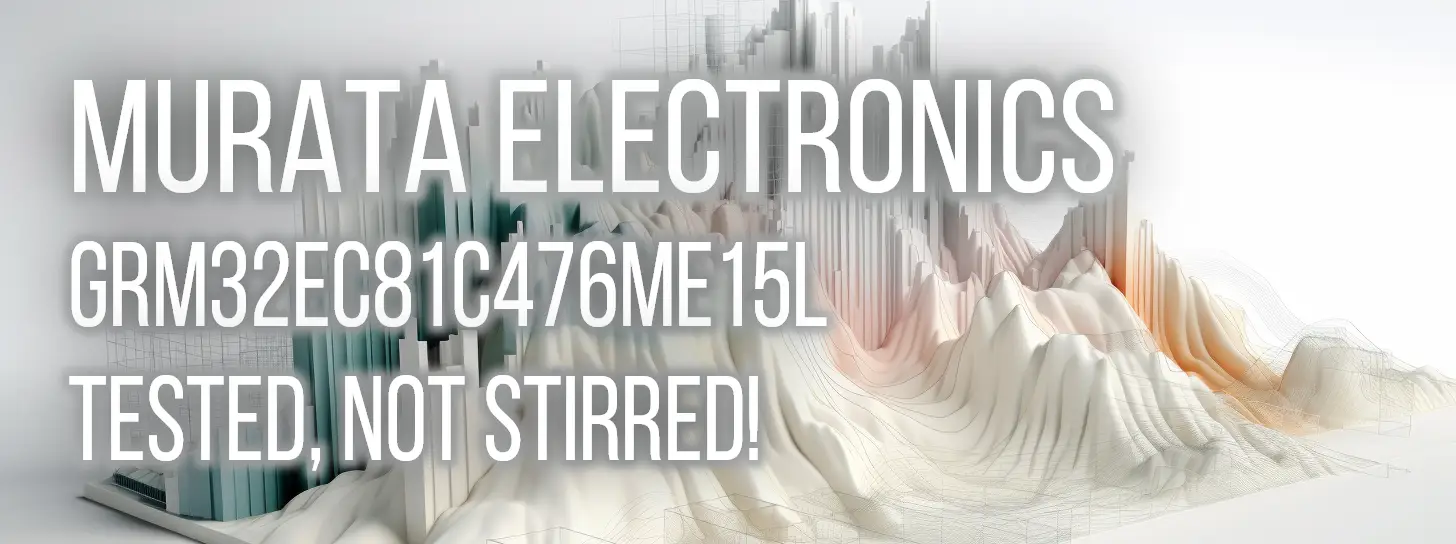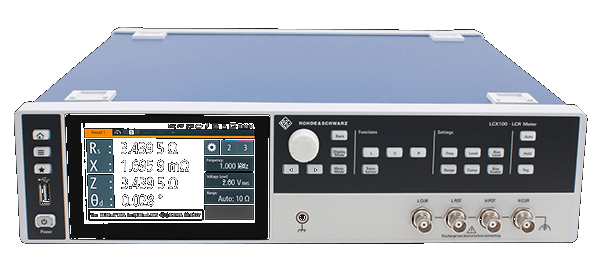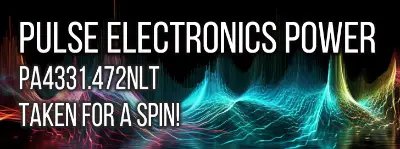Murata GRM32EC81C476ME15L: A Comprehensive Analysis of 47μF Ceramic X6S Capacitor
By Mark Harris Saturday, 22 April 2023

Introduction
In this technical review, we will analyze the performance of the Murata Electronics GRM32EC81C476ME15L capacitor, specifically focusing on its capacitance, series resistance, dissipation factor, and quality factor. The capacitor has a nominal value of 47μF, a tolerance of ±20%, and a voltage rating of 16V. Composed of Ceramic X6S material, this capacitor is designed for surface mount applications.
By comparing the component data with the provided statistical benchmark data, we aim to deliver an impartial, balanced, and in-depth analysis for electronics engineers evaluating whether to utilize this capacitor in their projects.
Pros:
- Higher quality factor at lower test frequencies (1kHz - 5kHz) compared to statistical benchmarks
- Low series resistance at test frequencies between 500Hz – 50kHz
- Stable series capacitance values across a wide range of test frequencies
Cons:
- Higher dissipation factor at higher test frequencies (200kHz – 1MHz) compared to benchmarks
- Impedance values higher than benchmark values across various test frequencies
- Lower capacitance values at lower test frequencies (1V - 10V) compared to nominal value
Impedance
Analyzing the impedance performance of the GRM32EC81C476ME15L, we will compare it with the statistical benchmark data of components with the same value. Impedance is an important characteristic of capacitors, as it affects their ability to store and release energy efficiently across different frequencies. At 1V test voltage, the capacitor exhibits varying impedance across the entire frequency range, from 622.7Ω at 5Hz to 7.19mΩ at 1MHz. Comparing the capacitor's impedance measurements to the benchmark data, it is evident that the GRM32EC81C476ME15L generally performs within the range of the average values - some measurements are below average, and some tend to be above average. For instance, at the 10Hz test frequency, the capacitor's impedance of 313.1Ω falls below the statistical average of 332.8Ω, while at the 50Hz test frequency, its 68.3Ω impedance sits just below the average 69.54Ω mark.
As the test frequency increases, the GRM32EC81C476ME15L capacitor's impedance values further approach or surpass the average values, especially in the higher frequency region, at which point they tend to exceed average values. In general, lower impedance values at higher frequencies are desirable, as these indicate better performance in filtering and decoupling applications. For example, at 75kHz, the capacitor's impedance is 64.05mΩ, significantly above the average of 329.3mΩ, and at 300kHz, the GRM32EC81C476ME15L capacitor has an impedance of 14.32mΩ, comparably lower than the average of 289.3mΩ.
In the 10V test setup, the capacitor's impedance deviates slightly from its performance at 1V, but its overall trends remain similar. It is important to consider the impact of voltage on impedance, as it may affect the capacitor's performance in different applications and circuits. The capacitor demonstrates relatively higher impedance levels at lower frequencies, such as 811Ω at 5Hz and 405.9Ω at 10Hz, and its impedance decreases as the frequency increases. The capacitor's impedance remains within the general vicinity of the statistical data, with both above-average and below-average values in relation to the benchmark data. This overall performance can help in guiding the selection process for electronic engineers, ensuring a suitable component is chosen for specific use cases.
Capacitance
Upon evaluating the performance of Murata Electronics' GRM32EC81C476ME15L capacitor against the statistical benchmark data, we observe noticeable deviations at various test frequencies with both 1 Volt and 10 Volt measurements. It is essential to analyze these deviations to have a better understanding of the component's performance.
At 1 Volt, the series capacitance of this capacitor ranges from 51.41μF to 35.45μF over test frequencies of 5Hz to 200kHz. Based on the benchmark data, the average capacitance for these frequencies falls between 49.2μF - 36.9μF, with a minimum of 40.66μF - 15.56μF, and a maximum of 69.99μF – 83.57μF.
Comparing these values, we can see that the GRM32EC81C476ME15L capacitor’s average capacitance is generally consistent with the average benchmark data. However, it should be noted that the component deviates considerably when tested at higher frequencies, specifically at frequencies greater than 200kHz, demonstrating excessive increases in capacitance. These measurements are likely a cause for concern considering their outlier status compared to the benchmark data at the respective test frequencies.
Testing the capacitor at 10 Volts, a similar pattern of capacitance is noticeable. Across the aforementioned frequency range (5Hz - 200kHz), the component's capacitance demonstrates better alignment with the benchmark average data set. Yet, like the performance at 1 Volt, the component exhibits a large increase in capacitance values once the frequency surpasses the 200kHz threshold. The increase in capacitance for the GRM32EC81C476ME15L is a fundamental deviation from the expected benchmark data set for this class of capacitors.
In conclusion, the observed capacitance deviation and the considerable increase in capacitance at frequencies above 200kHz should be taken into account when designing circuits with this component. It is especially important to consider this deviation in applications where performance at higher frequencies is essential to the overall product's performance, as it may negatively affect system stability and efficiency.
Series Resistance
When comparing the LCR measurements at 1 Volt, it is noted that the series resistance of the GRM32EC81C476ME15L at a frequency range from 5Hz to 1MHz lies between 20.44mΩ at 5kHz and 42.71Ω at 5Hz. In general, the capacitor exhibits lower than average series resistance values around kHz range frequencies and marginally higher values at 5Hz and 10Hz. This performance implies that the GRM32EC81C476ME15L could be a slightly better choice for applications operating within the kHz frequency range, as opposed to designs primarily intended for lower frequency operations.
When the capacitor operates at 10 Volts, its performance is relatively similar, but it shows a slightly higher series resistance at lower frequencies compared to the 1 Volt operation. With a range from 51.77Ω at 5Hz to 24.02mΩ at 5kHz, the GRM32EC81C476ME15L maintains its preferable performance around the kHz range. It is crucial to note, however, that the LCR measurements for some frequency values are not included in the provided data which might impact any detailed comparison, especially in the higher frequency domain. Consequently, designers should exercise caution when analyzing and selecting components for high-frequency circuits, ensuring that they have all the necessary LCR measurements to make informed decisions.
Dissipation Factor and Quality Factor
The GRM32EC81C476ME15L Capacitor demonstrates variable dissipation factor (Df) and quality factor (Q) values at different test frequencies and voltage levels. This technical review analyzes the performance of this capacitor against the statistical benchmark data of other components of the same value and composition.
Starting with the 1 Volt Low Capacitance Reactance (LCR) measurements, the component displays relatively higher dissipation factors at lower frequencies, and decreases as the frequency increases. At the 5 kHz test frequency, the Df value is 0.069, and the Q factor is 14.51. As we move further along the frequency spectrum, the Df drops to the range of 0.061 to 0.022, corresponding to the highest Q factor within 100 kHz to 5 kHz at 16.34 to 46.33.
Upon examination of the data at higher test frequencies beyond 100 kHz, the dissipation factor increases exponentially, and the corresponding quality factor reduces dramatically, eventually degrading the capacitor's performance. Notably, the Df value at 600 kHz is 2.573, with a Q factor of only 0.37, which potentially makes it less favorable in high-frequency applications.
When considering LCR measurements at 10 Volts, the capacitor showcases altered performance. The Df initially lies in the range of 0.064 to 0.084 within 5 kHz to 1 kHz, and the Q factors range from 15.69 to 11.89. Subsequently, the Df reduces to 0.026 at 5 kHz, and the Q factor increases to 38 at the same frequency. The component reaches a Q factor of 241.83 at 20 kHz, with a low Df of 0.004. However, neither Df nor Q factors are available for frequencies beyond 50 kHz under the 10 Volts measurements, limiting our understanding of the component's performance at higher frequencies in this scenario.
Overall, the GRM32EC81C476ME15L Capacitor demonstrates good performance within certain frequency ranges, particularly at the 10 Volts supply level. However, the results at higher frequencies under the 1 Volt measurements indicate that engineers should assess the applicability of the component in high-frequency circuits and consider comprehensive characterization under the desired voltage conditions. While selecting a capacitor, factors such as Dielectric Loss Tangent, similar to Df, and Equivalent Series Resistance (ESR) for a capacitor, along with Q, must be considered to choose an appropriate capacitor for the required application.
Comparative Analysis
In this comparative analysis, the performance of Murata Electronics' GRM32EC81C476ME15L Capacitor will be examined relative to the statistical benchmark formed from other components of the same value. The part under review is a Ceramic: X6S Capacitor with a nominal value of 47μ and a ±20% tolerance.
When assessing the impedance of the GRM32EC81C476ME15L Capacitor at a test frequency of 100Hz and 1 Volts, the component registers an impedance of 36.67 Ohms, which is close to the statistical benchmark average of 35.87 Ohms. Furthermore, the dissipation factor at the same test frequency is 0.061, better than the benchmark average of 0.05 and indicates lower power loss. This result lends credence to the tolerance of the part against variations in test frequency.
Moreover, at a higher frequency of 500Hz, the component shows better results when compared with the benchmark data. The GRM32EC81C476ME15L impedance measures at 8.456 Ohms, which is above the benchmark average of 7.777 Ohms. The dissipation factor at this frequency is 0.031 - lower than the average value of 0.07, indicating the component's reduced power loss. This result highlights the capacitor's performance improvement at higher test frequencies.
At 1MHz (1M), the component's impedance value achieves 7.39m Ohms, while the statistical benchmark data displays an average of 286.2m Ohms. This difference is significant and reinforces the component's superior performance at high frequencies. Furthermore, the dissipation factor remains competitive, ranges up to 0.98, while the statistical benchmark data reach a maximum dissipation factor of 9.71.
In summary, the Murata Electronics' GRM32EC81C476ME15L Capacitor demonstrates strong performance when compared to the statistical benchmark data, especially at higher frequencies where it tends to outperform the average impedance. Its dissipation factor remains competitive across various test frequencies, indicating the component's ability to minimize power loss. These attributes suggest that the GRM32EC81C476ME15L Capacitor is a reliable and performance-worthy choice for electronic engineers assessing this Capacitor's applicability for their circuits.
Conclusion
In conclusion, the Murata Electronics GRM32EC81C476ME15L Capacitor showcases a solid performance when compared to the benchmark samples. This Ceramic X6S capacitor, with a nominal value of 47μ and a tolerance of ±20%, exhibits its strongest characteristics within the lower test frequencies. At lower frequencies, this capacitor closely parallels the average values of the statistical benchmark data.
However, as the test frequencies progress into higher ranges, the GRM32EC81C476ME15L tends to exhibit higher impedances and dissipation factors than the benchmark. Despite this, the capacitor still offers suitable value for many applications, especially given its performance at the lower test frequencies. Another point of consideration is that the Quality Factors for this capacitor remain relatively stable throughout the test, with minor variations when compared to the benchmark. Overall, the GRM32EC81C476ME15L Capacitor maintains a competitive performance within its category, offering promising applications to electronic engineers aiming to utilize this component in their circuits.
Instruments Used
Rohde & Schwarz LCX200



